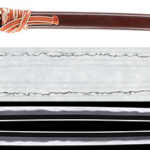Ordering number:24034
Katana in Shirasaya (The 68th NBTHK Juyo Token)
Signature: Mumei (attributed to Rai Kunimitsu)
無銘 (来国光)
Sayagaki: Juyo Token No. 68
Jōshū Rai Kunimitsu, O-Suruage mumei (unsigned).
This sword has a wide blade and a medium kissaki, showing a sturdy shape. The kitae is fine koitame with a layer of fine ji-nie.
The hamon is a tasteful chu-suguha with small nie, a bright nioiguchi, and ends in a small maru-bōshi.
This elegant sword demonstrates the traditional style of this smith.Blade Length: 2 Shaku 2 Sun 9 Bu.
Written by Mr. Tanobe.
Chu-koto: Saijyo Saku: Yamashiro
We divide 4 sections for each sword as Saijyo Saku, Jyojyo Saku, Jyo Saku and Regular Saku. This sword is ranked as Saijyo Saku for Rai Kunimitsu.
Polished.
Habaki: Gold double-layered.
Blade length: 69.6 cm (27.40 in).
Curvature: 1.2 cm (0.47 in).
Mekugi hole: 4.
Width at base (Motohaba): 3.06 cm.
Width at tip (Sakihaba): 2.15 cm.
Thickness (Kasane): 0.59 cm.
Sword weight: 685 grams.
Era: Late Kamakura period, Genko 1311.
Shape: O-suriage mumei with a wide blade, thick kasane, and bo-hi carved on both sides, extending to the tip, creating a well-balanced shape.
Jigane: Well-forged ko-mokume hada with a faint utsuri, representing the finest jigane of Yamashiro.
Hamon: Deep nioiguchi suguha with soft ko-ashi. The boshi is slightly irregular and returns in a ko-maru shape.
Features: "Rai" refers to a famous swordsmith school from Yamashiro, continuing from Kuniyoshi to Kunitsugu and Kunimitsu. Rai Kuniyuki, a descendant of Kuniyoshi, was reputed to be a craftsman originally from a foreign background, and his exceptional skills earned him the surname "Rai" from the court. During the ancient period, many skilled craftsmen from Korea and China settled in Japan, and their high level of expertise in metalworking was highly valued. Yamashiro, being in Kyoto, was renowned for producing the finest jigane for Japanese swords, indicating the superior skills and abilities of the Rai school. Some believe these craftsmen fled from invasions in China and were highly regarded in Japan for their superior skills.
Aoi Art’s Comment: This piece was previously marked with a vermillion signature and Hon'ami Kaou seal, but these were removed and the sword was appraised as mumei for the 68th Juyo Token designation. The appraisal process was extremely strict. This piece showcases the excellent jigane and deep nioiguchi suguha with soft ko-ashi. The more you examine it, the more you can appreciate the fine jigane, the depth of the hamon, and the integrity of the boshi. Highly recommended.
The 68th NBTHK Juyo Token.
Aoi Art estimation paper.
Whole Oshigata.
Order Form
Related Items:
 Katana: Mumei(judged as Den Rai Kunimitsu)(NBTHK Tokubetsu Hozon Token)
Katana: Mumei(judged as Den Rai Kunimitsu)(NBTHK Tokubetsu Hozon Token)
 Katana: Mumei (attributed to Den Rai Kunitoshi)(NBTHK 37th Juyo Token)
Katana: Mumei (attributed to Den Rai Kunitoshi)(NBTHK 37th Juyo Token)
 Katana :(Kiku Mon) Takai Echizen Kami Minamoto Rai Nobuyoshi (NBTHK Tokubetsu Hozon Token)
Katana :(Kiku Mon) Takai Echizen Kami Minamoto Rai Nobuyoshi (NBTHK Tokubetsu Hozon Token)
 Katana :Mumei(Den Mihara Masahiro) (Juyo Bijutsu)
Katana :Mumei(Den Mihara Masahiro) (Juyo Bijutsu)
 Katana: Hizen Kuni Kawachi Daijo Masahiro (first generation)(61st NBTHK Juyo Paper)
Katana: Hizen Kuni Kawachi Daijo Masahiro (first generation)(61st NBTHK Juyo Paper)
 Dai Sho:Tsushima Kami Tachibana Nyudo Tsunemitsu
Dai Sho:Tsushima Kami Tachibana Nyudo Tsunemitsu






